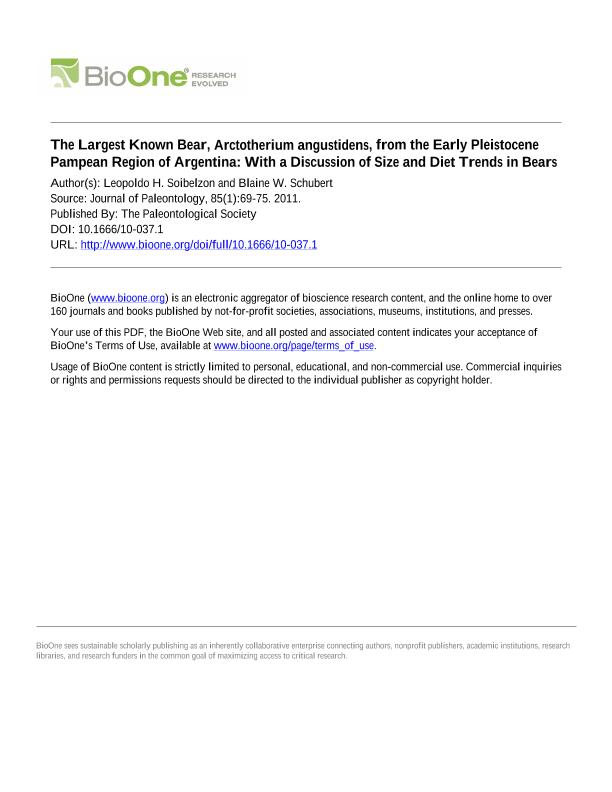Mostrar el registro sencillo del ítem
dc.contributor.author
Soibelzon, Leopoldo Héctor

dc.contributor.author
Schubert, Blaine W.
dc.date.available
2020-05-05T14:03:40Z
dc.date.issued
2011-01
dc.identifier.citation
Soibelzon, Leopoldo Héctor; Schubert, Blaine W.; The largest known bear, Arctotherium angustidens, from the early Pleistocene Pampean region of Argentina: with a discussion of size and diet trends in bears; Paleontological Society; Journal of Paleontology; 85; 1; 1-2011; 69-75
dc.identifier.issn
0022-3360
dc.identifier.uri
http://hdl.handle.net/11336/104215
dc.description.abstract
The South American giant short-faced bear (Arctotherium angustidens Gervais and Ameghino, 1880) is one of five described Arctotherium species endemic to South America and it is known for being the earliest, largest, and most carnivorous member of the genus. Here we report an extraordinarily large A. angustidens individual exhumed from Ensenadan sediments (early to middle Pleistocene) at Buenos Aires Province, Argentina. Based on overall size, degree of epiphyseal fusion, and pathologies, this bear was an old-aged male that sustained serious injuries during life. Body mass of the bear is estimated and compared to other ursid species based on a series of allometric equations. To our knowledge, this specimen now represents the largest bear ever recorded. In light of this discovery, we discuss the evolution of body size in Arctotherium (from large-to-small) and compare this to bears that exhibited different evolutionary trajectories. We suggest that the larger size and more carnivorous nature of A. angustidens, compared to later members of the genus, may reflect the relative lack of other large carnivores and abundance of herbivores in South America just after the Great American Biotic Interchange.
dc.format
application/pdf
dc.language.iso
eng
dc.publisher
Paleontological Society

dc.rights
info:eu-repo/semantics/openAccess
dc.rights.uri
https://creativecommons.org/licenses/by-nc-sa/2.5/ar/
dc.subject
URSIDAE
dc.subject
ARCTOTHERIUM
dc.subject
SOUTH AMERICA
dc.subject.classification
Paleontología

dc.subject.classification
Ciencias de la Tierra y relacionadas con el Medio Ambiente

dc.subject.classification
CIENCIAS NATURALES Y EXACTAS

dc.title
The largest known bear, Arctotherium angustidens, from the early Pleistocene Pampean region of Argentina: with a discussion of size and diet trends in bears
dc.type
info:eu-repo/semantics/article
dc.type
info:ar-repo/semantics/artículo
dc.type
info:eu-repo/semantics/publishedVersion
dc.date.updated
2020-05-04T19:50:23Z
dc.journal.volume
85
dc.journal.number
1
dc.journal.pagination
69-75
dc.journal.pais
Estados Unidos

dc.journal.ciudad
Lawrence
dc.description.fil
Fil: Soibelzon, Leopoldo Héctor. Universidad Nacional de La Plata. Facultad de Ciencias Naturales y Museo. División Paleontología Vertebrados; Argentina. Consejo Nacional de Investigaciones Científicas y Técnicas. Centro Científico Tecnológico Conicet - La Plata; Argentina. University of Tennessee; Estados Unidos
dc.description.fil
Fil: Schubert, Blaine W.. University of Tennessee; Estados Unidos
dc.journal.title
Journal of Paleontology

dc.relation.alternativeid
info:eu-repo/semantics/altIdentifier/url/https://www.cambridge.org/core/journals/journal-of-paleontology/article/largest-known-bear-arctotherium-angustidens-from-the-early-pleistocene-pampean-region-of-argentina-with-a-discussion-of-size-and-diet-trends-in-bears/4C57849BCD2535F80A9BC928F7081400
dc.relation.alternativeid
info:eu-repo/semantics/altIdentifier/doi/http://dx.doi.org/10.1666/10-037.1
Archivos asociados
